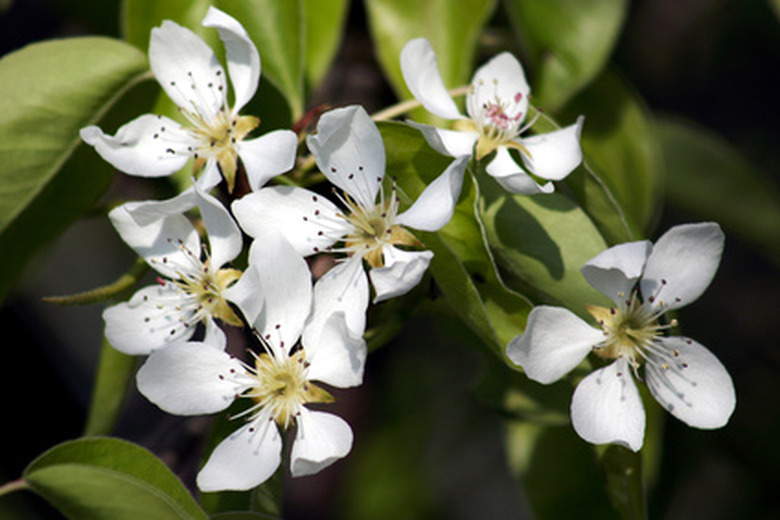How To Care For Redspire Pear Tree
Things Needed
- Wood chip mulch
- Compost
- Pruning shears
- Pruning loppers
- Pruning saw
- Dormant oil spray
Redspire callery pear is an ornamental pear tree grown in many parts of the United States. Hardy from USDA Plant Hardiness Zones 5A and 9A, the tree has an upright, columnar growth that fits well in small spaces. The fast-growing tree reaches heights of 35 to 45 feet and stands 20 feet wide. The tree produces white flowers in early spring, followed by red-tinged green leaves and red-brown fruit in the fall. The fruit is loved by birds and wildlife, but can become a nuisance. Redspire pear trees are longer-lived than Bradford pears, but have a similar tightly branched growth pattern.
Pruning
Step 1
Prune redspire pear trees in late winter while they are dormant. Cut out dead, diseased or crossing limbs with your pruning tools. Use pruning shears for branches 1/2 inch or smaller. Cut limbs 1/2 inch to 2 inches with pruning loppers. Use a pruning saw for larger branches.
- Redspire callery pear is an ornamental pear tree grown in many parts of the United States.
- Redspire pear trees are longer-lived than Bradford pears, but have a similar tightly branched growth pattern.
Step 2
Cut out vigorous vertical branches growing 2 feet or less from the interior of the tree, and any growing 12 inches or less from each other. Redspire pears have a very upright growth habit. Encouraging these trees to produce strong lateral branches with fewer, crowded vertical branches will keep the tree healthy.
Step 3
Cut back the canopy of the tree by up to 2 feet each year to control height if desired. Make cuts 1/4 inch above healthy, outward facing buds.
General Care
Step 1
Water the tree every two weeks during dry periods in the summer and monthly during the winter. Water trees less than 2 years old twice as often. Redspire pear trees are drought tolerant, but occasional watering will improve their health and increase fruiting.
- Cut out vigorous vertical branches growing 2 feet or less from the interior of the tree, and any growing 12 inches or less from each other.
- Cut back the canopy of the tree by up to 2 feet each year to control height if desired.
Step 2
Spread 3 shovelfuls of compost around the base of the tree in early spring. Redpsire pear trees need little fertilization, but compost adds nutrients and conserves moisture.
Step 3
Apply a 3-inch layer of wood chip mulch around the base of the tree to conserve moisture and protect the tree from heaving soils in the winter. Don't mound the mulch around the trunk, though, because it may harbor insects.
Step 4
Spray the tree in early spring with dormant oil spray according to package directions to combat aphids, borers and scale if you notice a problem with disease or pests, including oozing from the trunk, holes in the trunk or black spots on the trunk or leaves.
Tip
Redspire pear trees grow in any soil–clay, sandy, acidic or alkaline. The only soil requirement they have is well-drained soil, because they rot if their roots are left in water. Grow redspire pear trees in full sun in almost any location. They tolerate street traffic and pollution so they are a good choice for medians and street landscapes.
References
- Ohio State University Extension Fact Sheet: Pruning Mature Apples and Pears
- "The Garden Primer"; Barbara Damrosch; 1988
